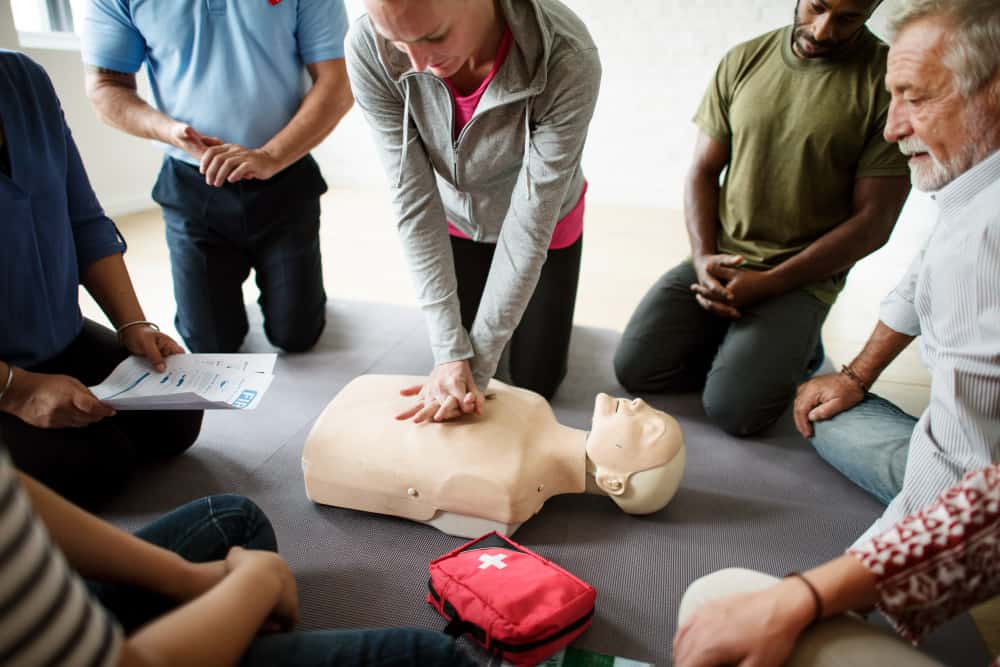Beyond deadlines and meetings, prioritizing health and safety topics in the workplace is the foundation of a thriving professional ecosystem. Today, let's dive into 21 fundamental workplace safety topics that often fly under the radar. From recognizing potential hazards to fostering a safety culture, join us as we explore the ins and outs of safety topics at the workplace.
Table Of Contents
- What Is Workplace Safety?
- Key Components Of Workplace Safety
- 21 Workplace Safety Topics
- 1. Emergency Preparedness and Response
- 2. Hazard Communication
- 3. Personal Protective Equipment (PPE)
- 4. Machine Safety
- 5. Workplace Ergonomics
- 6. Fall Protection
- 7. Electrical Safety
- 8. Fire Safety
- 9. Hazardous Materials Handling
- 10. Confined Space Entry
- 11. Workplace Violence Prevention
- 12. Noise Exposure
- 13. Respiratory Protection
- 14. Driving and Vehicle Safety
- 15. Mental Health and Stress Management
- 16. Distractions Created by Smartphones When Not in Use
- 17. Drug or Alcohol Abuse on the Job
- 18. Workplace Shootings
- 19. Workplace Suicides
- 20. Heart Attacks
- 21. Heat Stroke
- Key Takeaways
- FAQs
Tips For Crafting Impactful Training
- Planning a Training Session Effectively in 2025
- How To Host A Soft Skills Training Session At Work: The Complete Guide in 2025
- Training Checklist Examples: How To Have An Effective Employee Training in 2025
- Top 5 Staff Training Software That Are Most Used Now | Updated in 2025
- Diversity and inclusion in the workplace

Get your Audience Engaged
Start meaningful discussion, get useful feedback and educate your audience. Sign up to take free AhaSlides template
🚀 Grab Free Quiz☁️
What Is Workplace Safety?
Workplace safety refers to the measures and practices implemented to ensure employees' well-being, health, and security in a work environment. It includes a broad range of considerations to prevent accidents, injuries, and illnesses while promoting a conducive atmosphere for work.

Key Components Of Workplace Safety
Here are 8 key components of workplace safety:
- Physical: No slippery floors, wobbly equipment, or dangerous conditions.
- Ergonomics: Workspaces designed to fit your body, preventing muscle pain.
- Chemicals: Safe handling of chemicals with training, gear, and procedures.
- Fire: Prevention and response plans, including extinguishers, exits, and drills.
- Well-being: Addressing stress and promoting a positive workplace for mental health.
- Training: Learning how to work safely and what to do in emergencies.
- Rules: Following local, national, and international safety regulations.
- Risk Assessment: Finding and fixing potential hazards before they hurt someone.
By prioritizing workplace safety, organizations not only fulfill legal and ethical obligations but also create an environment where employees feel secure, valued, and motivated, ultimately contributing to increased productivity and a positive corporate culture.

21 Workplace Safety Topics
Workplace safety encompasses a wide range of topics, each crucial for creating a secure and healthy work environment. Here are some fundamental workplace safety topics:
1. Emergency Preparedness and Response
In the event of unforeseen circumstances, having a well-defined emergency preparedness plan is crucial. This includes understanding evacuation procedures, designating emergency exits, and conducting regular drills to ensure that employees are familiar with the protocol.
2. Hazard Communication
Effective communication about workplace hazards is vital. Ensuring proper labeling of chemicals, providing Material Safety Data Sheets (MSDS), and educating employees on the potential dangers of substances they work with are key components of hazard communication.
3. Personal Protective Equipment (PPE)
The correct use of personal protective equipment is essential in minimizing the risk of injuries. This includes training employees on when and how to use PPE, providing the necessary gear such as safety glasses, gloves, and helmets, and ensuring regular inspections for effectiveness.
4. Machine Safety
Machinery poses inherent risks in the workplace. Implementing proper machine guarding, lockout/tagout procedures during maintenance, and comprehensive training on the safe operation of equipment are critical components of machine safety.
5. Workplace Ergonomics
Ensuring ergonomic workstations is essential for preventing musculoskeletal disorders. Workplace safety topics under this category include proper desk and chair arrangements, ergonomic equipment, and encouraging employees to take breaks to avoid prolonged periods of inactivity.
6. Fall Protection
For jobs that involve working at heights, fall protection is paramount.
Workplace safety topics include the use of guardrails, safety nets, and personal fall arrest systems. Training on working safely at heights and regular equipment inspections contribute to a robust fall protection program.7. Electrical Safety
Electricity is a potent workplace hazard. Safety topics at workplace in electrical safety encompass proper use of electrical equipment, training on electrical hazards, cord safety, and ensuring that wiring and outlets meet safety standards.
8. Fire Safety
Preventing and responding to fires is a critical workplace safety topic. These workplace safety topics include having fire extinguishers readily available, establishing emergency evacuation routes, and conducting regular fire drills to ensure employees are familiar with emergency procedures.
9. Hazardous Materials Handling
For workplaces dealing with hazardous materials, proper handling is paramount. This involves employee training, the use of appropriate storage containers, and adherence to safety protocols outlined in Material Safety Data Sheets (MSDS).
10. Confined Space Entry
Working in confined spaces introduces unique risks. Workplace safety topics in confined space safety include atmospheric testing, proper ventilation, and the use of permits to control access and monitor activities within confined spaces.
11. Workplace Violence Prevention
Addressing the potential for workplace violence is crucial for employee well-being. Prevention measures include creating a supportive work culture, implementing security measures, and providing training on recognizing and de-escalating potentially violent situations.
12. Noise Exposure
Excessive noise in the workplace can lead to hearing loss.
Workplace safety topics in noise exposure safety include conducting regular assessments, providing hearing protection where necessary, and implementing engineering controls to reduce noise levels.13. Respiratory Protection
For environments with airborne contaminants, respiratory protection is vital. This includes training on the use of respirators, fit testing, and ensuring that employees have access to the appropriate respiratory protection equipment (RPE).
14. Driving and Vehicle Safety
For jobs involving driving, ensuring vehicle safety is paramount. Workplace safety topics include defensive driving training, regular vehicle maintenance, and enforcing policies against distracted driving.
15. Mental Health and Stress Management
Employee well-being extends beyond physical safety. Addressing mental health and stress management involves fostering a positive work culture, providing support resources, and promoting work-life balance.

16. Distractions Created by Smartphones When Not in Use
With the prevalence of smartphones, managing distractions in the workplace has become a significant concern. Workplace safety topics include establishing clear policies regarding smartphone usage during work hours, especially in safety-sensitive areas, and providing training on the potential dangers of smartphone distractions and their impact on overall workplace safety.
17. Drug or Alcohol Abuse on the Job
Substance abuse in the workplace poses serious risks to the well-being of employees and the overall safety of the work environment.
Workplace safety topics in this category include Drug and Alcohol Policies, Employee Assistance Programs (EAPs), and the dangers of drug and alcohol abuse, along with information about available resources for assistance.18. Workplace Shootings
Addressing the threat of workplace shootings is a critical aspect of ensuring the safety of employees. Workplace safety topics include training sessions to prepare employees for potential active shooter situations. Implementing security measures such as access controls, surveillance systems, and panic buttons. Developing clear and effective emergency response plans in the event of an active shooter incident.
19. Workplace Suicides
Addressing mental health concerns and the risk of workplace suicides is a delicate but crucial aspect of workplace safety. Workplace safety topics include Mental Health Support Programs, which promote a culture that encourages open discussions about mental health to reduce stigma and encourage seeking help. Providing training on recognizing signs of distress and creating a supportive environment for colleagues.
20. Heart Attacks
Work-related stress and sedentary lifestyles can contribute to the risk of heart attacks.
Workplace safety topics under this category include programs that promote healthy lifestyles, including physical activity, a balanced diet, and stress management. First Aid Training: including recognizing the signs of a heart attack and the appropriate response.21. Heat Stroke
In environments where heat is a factor, preventing heat-related illnesses, including heat stroke, is essential. Workplace safety topics include Hydration Policies: Encouraging and enforcing regular hydration breaks, especially in hot conditions. Heat Stress Training: Training on the signs of heat-related illnesses and the importance of acclimatization for new employees. Providing appropriate PPE, such as cooling vests, for employees working in high-temperature environments.
Key Takeaways
Prioritizing workplace safety is not just a legal requirement but a moral obligation for employers. Addressing a diverse range of workplace safety topics ensures the well-being of employees, and a positive work culture, and contributes to overall productivity. From emergency preparedness to mental health support, each safety topic plays a vital role in creating a secure work environment.

Elevate your safety training with AhaSlides!
Leave behind the days of dull, ineffective safety meetings! AhaSlides empowers you to create engaging, memorable safety training experiences through its library of ready-made templates and interactive features. Engage your audience with polls, quizzes, open questions, and word clouds to gauge their understanding, stimulate participation, and collect valuable feedback in real time. Elevate your safety training beyond traditional methods and cultivate a thriving safety culture within your workplace!
FAQs
What are 10 safety rules?
Follow proper lifting techniques to avoid strain.
Keep work areas clean and organized.
Use tools and equipment correctly.
Report hazards and unsafe conditions promptly.
Follow emergency procedures and evacuation routes.
Do not engage in horseplay or unsafe behavior.
Follow lockout/tagout procedures during maintenance.
Never bypass safety devices or guards on machinery.
Always use designated walkways and follow traffic rules.
What are 5 fundamental safety concepts?
Hierarchy of Controls: Prioritize control measures—elimination, substitution, engineering controls, administrative controls, and personal protective equipment (PPE).
Safety Training and Education: Ensure employees are informed and trained on safety protocols.
Incident Investigation: Analyze accidents and near misses to prevent future incidents.
Safety Culture: Foster a workplace culture that prioritizes and values safety.
Ref: Indeed | Safety Talk Ideas








